One of the great things about running a site like soccerdrillsapp.com is that we interact with our followers by receiving feedback or questions from them. This interaction allows us to fill the holes that are either unintentionally left in our practice sets, or we are just starting to scratch the surface of.
Several of our followers have recently sent us a request for ideas on defensive drills. Incidentally, at a practice two nights ago, I overheard some parents talk (parents never complain) about how their kids’ team never works on defense.
One of the reasons why defense is often overlooked in practices is that coaches tend to think that every bit of practice needs to be spent with balls at players’ feet. Dribbling, juggling, passing, trapping, shooting, scrimmaging, etc., all involve players either constantly touching a ball or at least within the vicinity of one.
Most of the teaching focuses on the offensive aspects of the drill – make this move, shoot this way, use this part of the foot, etc. – and the defensive aspects are often only mentioned as a byproduct of the offensive drill.
As a response to this, we decided to provide some defensive drills and games that focus on individual and team defense, covering the following topics:
- Individual defending
- Stance
- Closing down the attacker
- Steering the attacker
- Jabbing at or gaining possession of the ball
- Team defending (in a separate post)
- Pressuring and supporting
- Transitioning to offense
Please also bear in mind 3 golden rules each defender must follow to succeed
- Always defend from the “goal side”
- Position yourself between the goal and the attacker
- When you get beaten, recover to the “goal side” (back and center of the field) as fast as you can before trying to win the ball
- Tackling from behind, especially in youth soccer, will result in fouls (and sometimes cards) more often than not – often even if the tackle was completely legal
- Do not “dive in”
- Stay on your feet, and do not turn your back.
- Slide tackling should only take place if you are 100% sure you will get the ball or you are in an act of desperation (only if I slide will I be able to stop a goal from being scored)
- Turning your back to avoid getting hit is only setting you up to be beaten by a “pump fake.” Getting hit by a soccer ball sure can sting, but that pain passes quickly and I have yet to hear of any amputations taking place because of a soccer ball. Besides, it often hurts just as bad if you get hit in the back, so just keep your eyes on the ball and the attacker. This is much better both for your safety and your team’s efficiency.
- Stay on your feet, and do not turn your back.
Individual Defending
Stance
In each of these drills – and whenever on defense during practice or a game – players should assume the following body position as they approach an attacker with the ball:
- Knees are bent
- Chest is leaning slightly forward
- Feet are about shoulder-width apart and staggered
- Do not let the feet cross (as if running), but instead always keep one foot ahead of the other (as if fencing)
- Always be on the balls of your feet, lively moving the feet in order to make small adjustments
- Do not be flat-footed
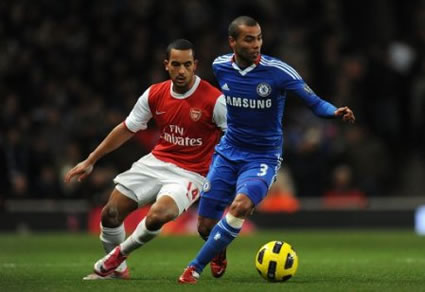
Theo Walcott (red) keeps his left foot in front of his right foot, and will continue to do so as long as Ashley Cole (blue) holds on to the ball
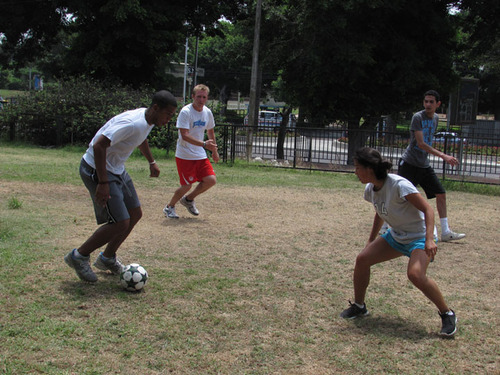
The player in the blue shorts assumes a proper defensive stance
Closing down the attacker
The following drill teaches the players how to approach an attacker (in this case a cone) with a slight bend to avoid the attacker blowing by the defender. Young players often make the mistake of going straight for the ball at full speed, but this allows the attacker to just push the ball by them and leave them in the dust. This brief drill teaches the appropriate approach to avoid that.
DRILL – 1 or 2 minutes
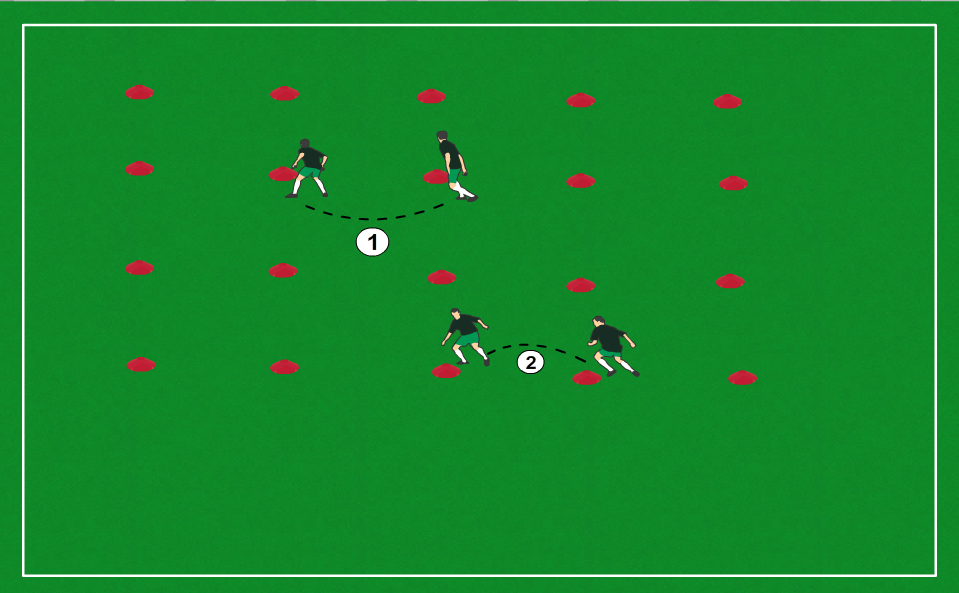
1. Show Left; 2. Show Right
- Set lines of 5 cones about 7 to 10 steps apart
- Players line up behind a cone (an attacker)
- 4 players for each line
- The last cone is left unattended so the player on a cone prior to it can run up to it
- No balls are needed for this drill
- 4 players for each line
- Every 5 to 10 seconds, the coach calls out either “Show Right!” or “Show Left!”
- Players bend their run to approach the cone
- Players sprint to get close to the player quickly
- But within the last 3 to 5 steps, players slow down and assume the proper defensive stance described above
- Players should leave 2 to 3 steps between the cone and themselves
- If “Show Left,” the players approach the cone, with a slight bend, from their left side to show the attackers their left side
- If “Show Right,” the players approach the cone, in a slight bend, from their right side to show the attackers their right side
- Players bend their run to approach the cone
- Players defend the cone that is ahead of them and roll forward with each call by the coach
- After the players defend the last cone in line, they quickly run to the beginning cone in their line to defend the next call
Steering the attacker
After the defender has shown the attacker which way to go, it is time to now steer the attacker into trouble, either into a teammate for a double team or towards a sideline or a goal line. Often, the defender will want to steer the attacker onto their weaker foot. So if the attacker is right footed, it helps if the defender “shows left,” forcing the attacker to use the less dominant foot.
At other times, it will be the position on the field that the attacker is in that determines which way to steer. If in the final third of the field, thus a danger to your goal, the attacker should always be steered towards the outside of the field – even if that means steering onto the more dominant foot.
Jabbing at or winning the ball
The attacker will make one of two choices when forced to go in the direction the defender chooses. Either the attacker will:
- Slow down and try to make a move – in hopes the defender will “dive in” and lose balance (why the stance is so important)
- In this case just use the front foot from your “fencing” stance to jab at the ball and see if you can knock it away from the defender
- Or try to outrun the defender down that side
- As a defender you will have 2 to 3 steps advantage against the attacker (the distance left when approaching the attacker), PLUS
- If you are in the correct stance, you will be ready to sprint because of your bent knees, chest leaning forward, and one foot in front of the other – just shift your body so that your hind foot becomes your front foot and take off in a sprint
- In this case, the moment the attacker takes too heavy of a touch, get between the attacker and the ball and shield it to gain possession
GAME – 10 to 15 minutes
Setup
- A 10×10 step box
- Balls are with the defenders
Objective
- The attacker wants to stop the ball on the defender’s end line
- The defender wants to either stop the ball on the attacker’s end line once it is stolen, or force the attacker out of bounds
- Even if the attacker goes over the end line, and does not stop the ball on the defender’s end line under control, it is the defender who wins the round
- In another variation of this drill, you may set up a goal on each end line and have the players score that way
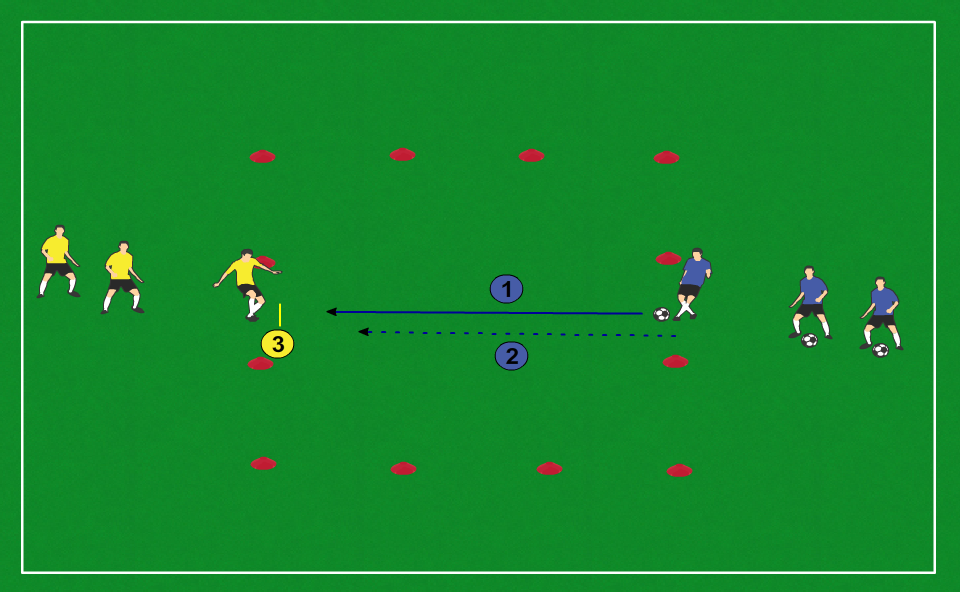
1. Defender passes the ball to the attacker; 2. Defender follows the pass by running to close down the attacker; 3. Attacker traps the ball in front
- The defender passes the ball to the attacker
- Make sure it is a well-weighted pass so the ball travels quickly, but not out of control
- The defender follows the pass with a run to close down the attacker as soon as possible
- The attacker traps the ball
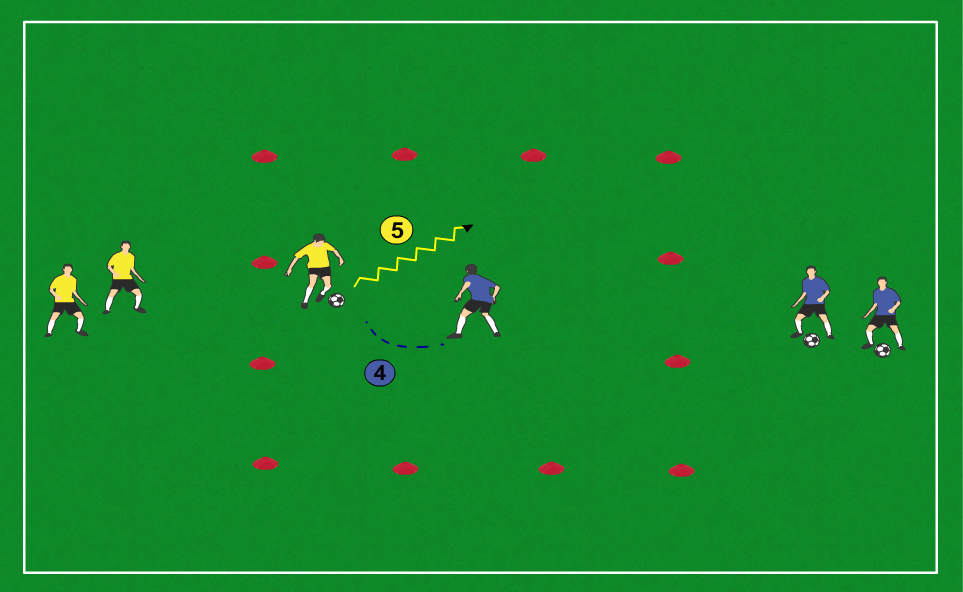
4. Defender bends the run on the last 3 or so steps of the close down to steer the attacker, leaving 2 to 3 steps of distance between self and attacker; 5. Attacker tries to beat the defender by running into space defender is forcing the attacker into.
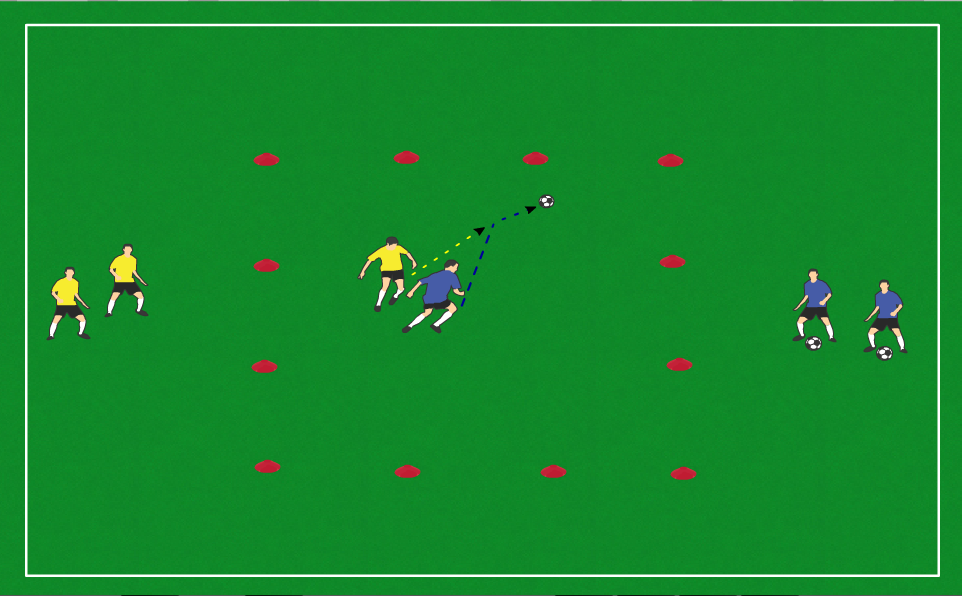
- The moment the attacker takes a heavy touch, the defender uses the better position (2 to 3 steps advantage) and sprinter’s stance (bent knees, chest forward, on the balls of the feet) to get in the attacker’s path, beat the attacker to the ball, and win possession

